
Original Link: https://www.anandtech.com/show/2577
Cooler Master UCP 900W
by Christoph Katzer on July 29, 2008 3:00 AM EST- Posted in
- Cases/Cooling/PSUs
Introduction
We've been eagerly awaiting our Cooler Master UCP sample; unfortunately, it was delayed an extra three weeks during shipment by the carrier. We first saw this new series at CeBIT 2008 earlier this year, and other than the name (previously called Ultimate Warranty Protection/UWP) not much has changed. This power supply has some impressive features and specifications, and we were definitely interested in putting it through our test regimen to see how it actually performs.

What's so special about Cooler Master UCP line? A press release points out the fact that they are the first company to receive an 80Plus Silver certification, which certainly generated some media attention. It's not that we've never seen an 88% efficiency power supply before, but the certification "guarantees" this level of performance to end-users. The difference between a regular 80Plus certification and an 80Plus Silver certification isn't all that great either, as it usually means only a few percent better efficiency overall. Even if you run the power supply constantly for years, you might only save $25. Still, it's a nice marketing tool, and there is an assumption that higher efficiency often means better overall quality. That may be true to a certain extent, but let's get to the rest of our testing before we come to any firm conclusions.
The 900W UCP that we received is quite long at 190mm (7.5 inches), with a 120mm fan toward the bottom-front of the casing (assuming a normal mounting position at the top of your computer chassis). Cooler master puts a large label on the top of the power supply, where it will be hidden in most computer cases. The 3.3V and 5V rails are rated at 25A, which is more than sufficient in our opinion. The 12V rails are the more important factor in modern systems, and here Cooler Master provides four 12V rails with different amperages. 12V1 is rated at 25A and is for the CPU, while 12V2 is only 20A and is also for the CPU socket.

The specifications state that the first 12V rail is for the ATX12V connector, but it actually is used for the 24-pin motherboard connector, the ATX12V 4-pin connector, and the various Molex/SATA connectors. The added amperage makes sense in that case, as much of the system will be powered through that rail. The second 12V rail is for the EPS12V 8-pin connector, while the two remaining 12V rails are for the six PEG connectors.
Going back to the main 12V rail, how much power a graphics card draws from the PEG connection and how much it draws from the motherboard x16 slot varies by design, so having so many peripherals dependent on the one 12V rail may not have been the best choice. This is another instance where a single large 12V rail can sometimes be a better solution. Regardless, very few systems will actually come anywhere near maxing out the available power, but if you plan on connecting several hard drives and overclocking a quad-core processor you might run into problems.
Packaging and Appearance

The power supply comes in a somewhat understated black box, and unlike some competitors it doesn't contain all sorts of extraneous details on the various sides. The front of the box only shows a picture of the power supply and its name, while the back is a little more informative and includes the specifications and an outline of the major features. Inside the package, there's a plastic cover providing some small protection for the power supply (and keeping various bits from falling out during shipping). You also get a manual on a CD (highly useful for assembling a system, especially if you're building your first system!), power cord, screws, and a card detailing the warranty and discussing the proper disposal of electronic components.

Cooler Master certainly created a unique looking product, as the power supply is coated with a rough texture and it has rounded edges. It seems they are going after the "heavy-duty" look, and the surface looks somewhat like the lining of a truck bed. The fan grille has the same coating and includes the obligatory Cooler Master logo. The grille is connected using hex screws, either because they simply look cleaner or to try and keep prying hands out of the internals. Regular Phillips screws would have done just as well.
The back of the unit is perforated by many small holes in order to provide proper ventilation. Cooler Master uses a large specialized power connector for the plug, typical of their high-end units. There's also a power switch and an LED that glows white when the PSU is connected to the power grid. Besides the ventilation holes at the rear of the power supply, the only other place for air to enter or exit the casing is through the fan grille. This should help to direct airflow, provide optimal cooling, and avoid creating extra turbulence.
Cables and Connectors

The large mass of cables is nicely bundled up during shipping, and all are sleeved with a black mesh, including sleeving in between connectors. This can increase the cost slightly, but for those who are fanatical about having clean wiring it's a nice extra. There are a total of four 6-pin and two 8-pin PEG connectors for graphics cards on four separate cables; two of the cables have a 6-pin and 8-pin connector while the other two each have a 6-pin connector. Some users might have difficulties with using the 8-pin connectors on certain 6-pin graphics cards, but with many of the newest GPUs requiring an 8-pin and a 6-pin connector there shouldn't be any serious problems; after all, it's unlikely people running old hardware are going to go out and buy a power supplies like this.
There are a fair number of peripheral connections available on several harnesses, but the overall harness length may not be long enough for a larger chassis, as the longest harness is only 75cm. Again with the 900W rating, it seems a lot of users would be likely to have a larger case that provides for better cooling opportunities, so that's something potential buyers will want to consider. The ATX cables are 60cm and 65cm long, which should work well whether your power supply is in the traditional location or at the bottom of your chassis (like in Cooler Master's own Cosmos case). However, there are still cases where you may require longer cables, so pay attention to that area before purchasing this power supply for use in your favorite chassis.
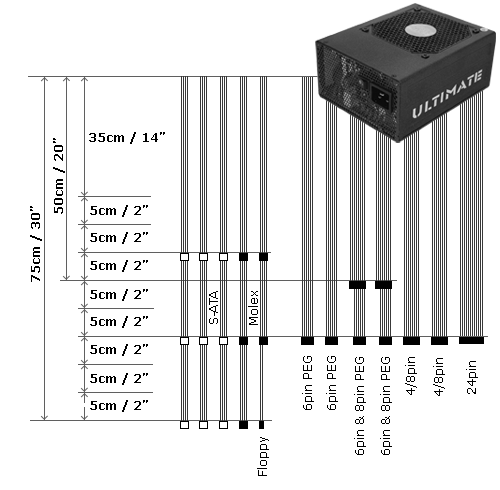
The Fan

The Cheng Home Electronic fan branded SuperRed can be found in many of the Acbel-made power supplies from Cooler Master. It spins at up to 2000RPM, which we will see later in our tests. For a 120mm fan, that should be more than enough to cool the 900W PSU, but at maximum speed the fan does get moderately noisy.
Internals

Opening up this unit we find a typical Acbel layout and heatsink design. We saw another power supply from a German company rated at 500W that used the same layout and reached an impressive 88% efficiency. With this power supply boasting the 80Plus Silver certification, we expect it to reach a similar level, so it seems Acbel has really made some progress during the last couple of years. Prior to that, we rarely saw anything but boring, mediocre designs from Acbel, which is why many of Cooler Master's previous products offered only average performance compared to the competition. Now Acbel seems to be pushing newer technologies, and we find several solid polymer aluminum (SPA) capacitors on the secondary side.
Looking at the overall build, and starting from the power input, we find a heavy-duty filtering stage, though several parts are not really secured to anything. The large sister PCB on the right side holds the standby circuit and uses reasonable quality parts. The main capacitors come from Hitachi, which is relatively common in high-end PSUs these days, although this time there are three capacitors. They are all rated at 390µF and 400V, and the three caps are a very nice addition.
On the secondary side, as mentioned above, we see many solid capacitors and a few from Ltec Taiwan. Looking closer at the PCB, there are some indications that there are six 12V rails, but two of the rails won't be in use since this is only a 900W power supply. There's little doubt that we will see a similar design rated at up to 1200W with six rails in the future.
Testing with the Chroma ATE Programmable Load
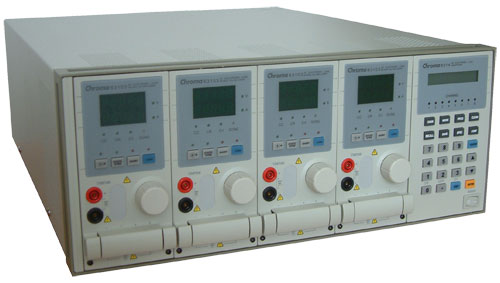
Our test equipment consists of two Chroma programmable DC Loads that enable us to test power supplies with an output of up to 1500W. The biggest advantage of the Chroma DC Loads is simply the high precision it provides. It can measure differences as small as 0.001V and 0.0001A, which will provide us with best-in-class results.
When programming the Chroma with specific amounts of load calculated according to the ATX norm, we are able to load power supplies to an exact percentage. We can now show results at every specific percentage needed. To get the best overview of a power supply, we load each unit with 10%, 20%, 50%, 80%, 100%, and 110% of the specified output. This is easy to calculate for a 1000W power supply: the 10% load is 100W and 110% load is 1100W. Remember that this is the amount of power the PSU delivers; due to inefficiencies, a power supply will actually draw more power from the wall.
Note: If you would like to know more about our testing methodology, equipment, and environment, please read our PSU testing overview.
We have added an additional 10% on the highest load to see how the units perform with overload. This test will be performed in all future reviews. The overload test is performed at room temperature as well as under more stressful conditions; to ensure we are not too cruel to the power supplies, we will keep the ambient temperature at 50°C in the stress test. Experience shows that many units can stand the overload at room temperature but will experience problems with higher temperature and overload together. Only the best-built units will survive this.
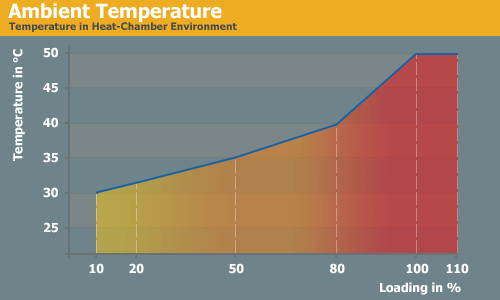
The Testing Environment
There is one flaw in testing power supplies with programmable loads while trying to measure the sound pressure levels at the same time. Because the programmable loads get very loud, there is no chance of hearing the power supply on the test stand. In order to make accurate measurements of the noise levels we needed a way to separate the test unit and the programmable loads. Our solution was to build a very thick box around the unit.
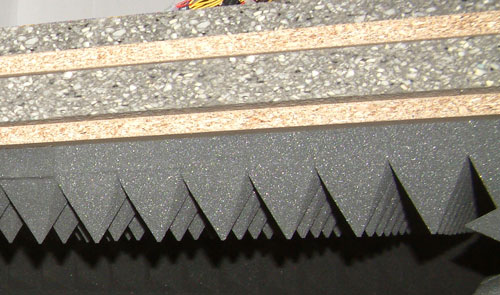
We concluded that a five-layer box with a total thickness of 6" (15cm) containing two layers of wood and three layers of special foam would suffice. It is designed as a box within a box. The inner box does not touch any part of the outer box, making it difficult for acoustic noise to pass through in the form of vibration. Each box is isolated on both sides with a layer of heavy foam that is normally used to insulate engines. On the inside we have an additional layer of 4" (10cm) thick pyramidal foam on every side of the box to eliminate the acoustic waves coming from the test object as well as we can.
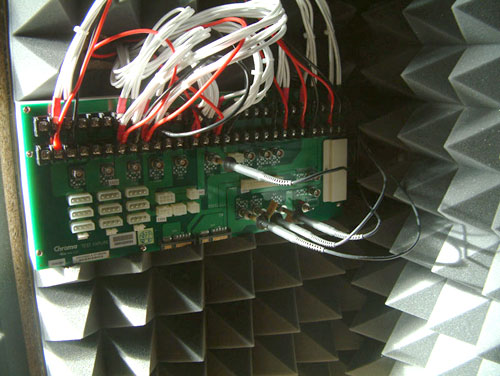
To ensure a completely closed system we installed the printed circuit board that the connectors of the power supply are attached to inside the anechoic room/box. In other box designs, you would need to put all the cables through the wall. Unfortunately, that would result in the inside of the box not being fully isolated anymore. Our design keeps everything that needs to be connected inside of the box and maintains isolation.
DC Outputs and Quality
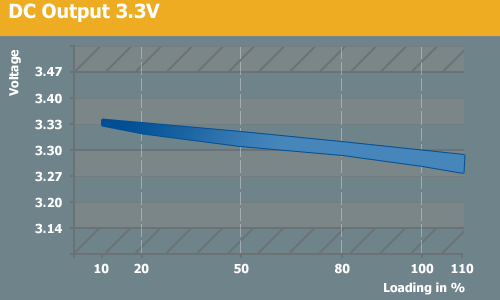
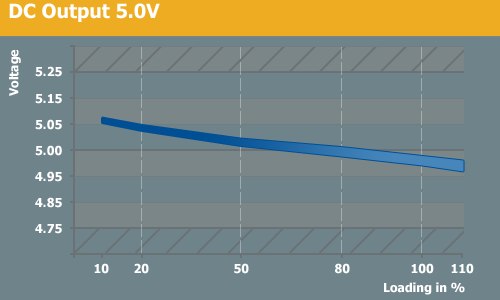
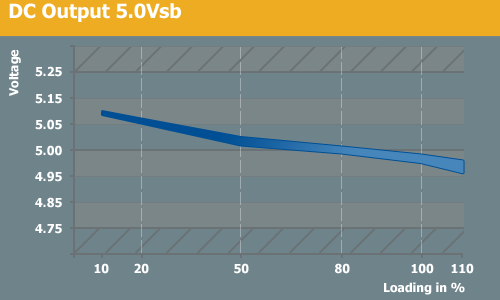
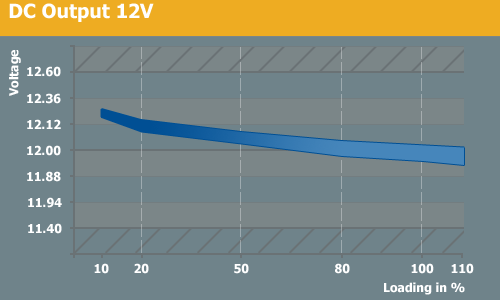
We see very little voltage drop on the rails, which is very good. All of the rails are within 2% to 2.5% of regulation, starting slightly higher than the target voltage and dropping slightly below target at higher loads. Ripple on the 12V rails is also exceptionally good, measuring at most 8mV. Lower voltage rails also perform decently, though not quite as good, measuring up to 21mV. The ability of this power supply to deliver the required wattage with little voltage drop even at higher loads leaves us with a good impression.
Efficiency and PFC
With the 80Plus Silver badge, we expect very high efficiency results. Just to clarify, an 80Plus certification requires that a power supply reach 80% efficiency at loads from 20% to 100%. 80Plus Bronze requires at least 82% efficiency at 20% load, 85% efficiency at 50% load, and 82% efficiency at 100% load. 80Plus Silver bumps the requirements up to 85%/88%/85% for the same 20%/50%/100% loads. In short, the Cooler Master 900W UCP had better be able to reach 88% efficiency.
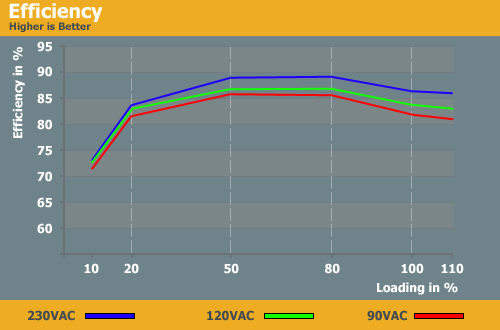
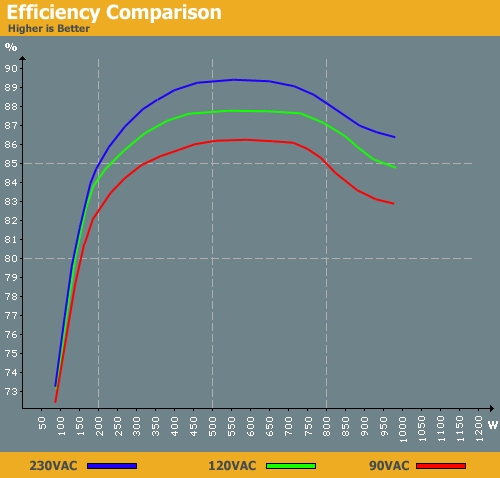
The results meet the 80Plus Silver requirements, actually reaching a maximum of 89% efficiency, but it's important to note that this is only possible on 230VAC. The 80Plus standard doesn't specifically state whether the efficiency should be measured on 230VAC or 115VAC, so we will have to give Cooler Master the benefit of the doubt. 115VAC users "only" get 87% efficiency. [Ed: Boohoo.] Regardless of how you look at it, this is the highest efficiency we have measured in a retail power supply to date.
Before you get too carried away with the high efficiency, however, we need to rain on your parade a bit. The 80Plus Silver badge means that most users will get at least 85% efficiency, but even 20% load represents a power output of 180W, which for an idle system represents a significant amount of high-end hardware. Optimal efficiency starts at around 350W, which pretty much means you will need a quad-core system with dual graphics cards as a reasonable minimum (and probably a bit of overclocking) in order to get full efficiency from this sort of power supply. But then you hopefully already realized this when you saw the 900W rating.
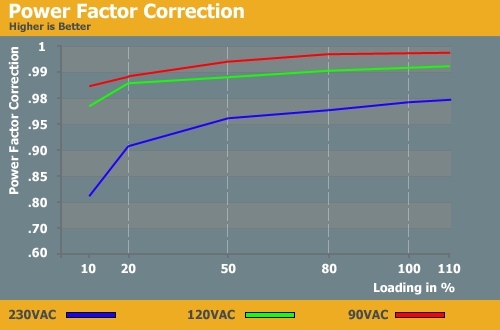
Another part of the 80Plus certification is that the power supply needs to reach at least .9 PFC, but it only needs to achieve this at 100% load. Needless to say, that's not a very difficult requirement to meet, and this PSU has a lower PFC than we have seen with most recent power supplies. PFC goes up with lower input voltages, but most power supplies easily break .99 PFC at lower loads with 115VAC. That said, the difference between .98 and .99 PFC obviously isn't very great, so this isn't something that should seriously concern potential buyers. The result could have been better, but it's not something to lose sleep over.
Temperatures, Fan Speed, and Acoustics
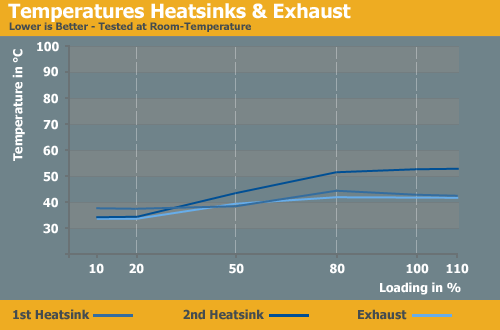
The two heatsinks remain at reasonable temperatures throughout testing. We've seen much worse results with other power supplies topping out at up to 90°C, so the worst result of ~54°C on the secondary heatsink is quite good. It reaches this point at about an 80% load, and then the fan speed increases and temperatures remain static up to 110% load. This indicates that everything is working properly and there shouldn't be any problems with long-term use of the power supply, and even if it's running at closer to 100% load.
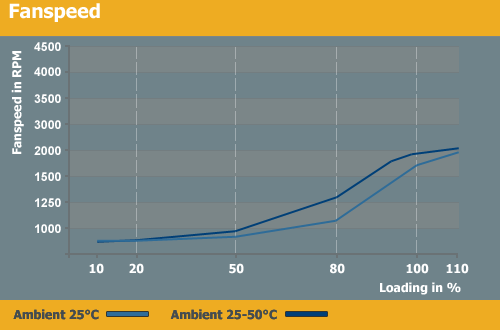
The fan spins at a relatively slow 860RPM up to a load of 300W, at which point it begins to spin faster. It's at 1100RPM at 80% load (720W), and it no longer qualifies as a quiet PSU. Beyond 80% load, fan speed increases rapidly up to the maximum 2000RPM, keeping things cool as we have seen in the temperature graph, but your ears might not be as happy....
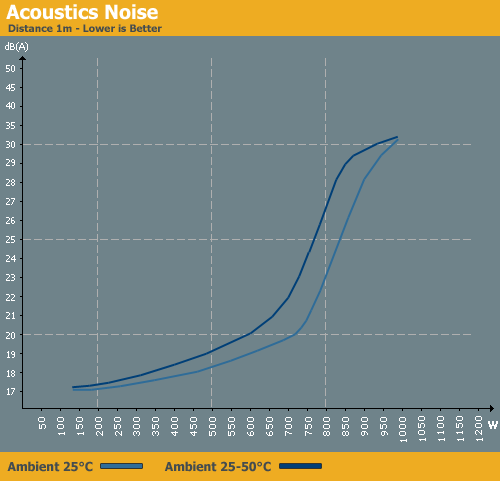
If your goal is to have a quiet or near-silent power supply, you will want to keep this PSU under 500W of load. Once we pass 700W, noise levels increase rapidly from 20dB(A) up to a maximum 31dB(A). Given the relatively tame temperatures, Cooler Master certainly could have lowered fan speeds and noise levels more, as the heat sinks are usually in the 40-50°C range. However, we won't complain too much as it will be quite difficult for most users to come anywhere near 100% load (or even 80% load) on this power supply.
Conclusion
As the first retail power supply to bear the 80Plus Silver badge, the Cooler Master UCP 900W certainly deserves some recognition. Some users might be able to stop right there and determine that's all they need to see before they run out and purchase a power supply, but we prefer to be a bit more circumspect. Up to 89% efficiency (87% on 115VAC) is a great result, but in order to reach that level of efficiency you will need to have a system drawing between 400 and 700W of power - and that's no mean feat. Furthermore, compared to a unit with "only" 86% efficiency (84% on 115VAC), you're looking at the difference of 20W at the outlet for a system that's using 500W of power. Running 24/7, that works out to somewhere around $13-$18 per year, and if you only use a system eight hours a day you're really only looking at about $5 per year in savings.
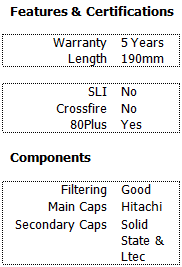 |
In short, an 80Plus certification indicates a certain level of quality and efficiency, and 80Plus Silver certification means potentially higher efficiency and in theory higher quality. The reality is that it's mostly marketing, and you will need to carefully evaluate your system requirements before determining whether such a badge is truly useful. All else being equal, the 80Plus Silver certification is a nice extra, but more likely than not you're going to be spending quite a bit more money for the privilege of owning such a product.
Even if there's a lot of marketing hype surrounding a product, that doesn't necessarily mean the product isn't worth buying, and the Cooler Master UCP 900W certainly has other points in its favor. It has a unique appearance that some users will really like, and the large "Ultimate" stickers will help you rest easy knowing that you have a really special PSU. The internal build quality is generally good, with a good choice of components; temperatures stay very low; and as expected we see very high efficiency levels over a large range of power output. The voltage regulation is also good, with little voltage drop or ripple. Finally, you get a 5-year warranty, which is better than most of the competitors (though there's no 48-hour service guarantee, unfortunately). These are all the good points, but what about the bad?
The distribution of the four 12V rails certainly leave something to be desired, with a large number of peripherals being powered by one 25A 12V rail. That rail handles the ATX12V 4-pin connector, the main 24-pin connector, and the peripheral connectors for hard drives and other devices. In certain systems, it would certainly be possible to overload this rail, particularly with an overclocked quad-core processor, several hard drives, and a high-end GPU sitting in your first PCI Express slot. We also felt that the cables tended to be on the shorter side of things for a 900W PSU, and in full tower cases users may not be able to reach all the necessary components.
The flipside of the low temperatures we recorded is that noise levels get a bit higher than we would like, at least at maximum load. If you are looking for a silent power supply, it's unlikely you will need a 900W PSU to begin with, and there are certainly quieter options on the market. If the power draw is below 350W, noise levels should be below 20dB, but then you will be in the less efficient operating range for this power supply. In short, you need to run a high-end system that has peak power requirements of at least 500W, to make use of the full potential this power supply has to offer.
The final remaining question is pricing, which is a bit difficult to determine at this time. Looking online, we were able to find exactly one retailer in the US, with a price of $250. Even better, they are currently out of stock (or perhaps not yet in stock). There are definitely power supplies with similar quality - and without the 12V rail distribution problems - available for less money. Even if the price is right, Cooler Master really needs to address the 12V rail problem before we can recommend this power supply; as it stands, that appears to be the Achilles' heel of the UCP 900W, which is unfortunate. Hopefully, it can be easily corrected, and we will update this article if we hear anything more on the subject.























